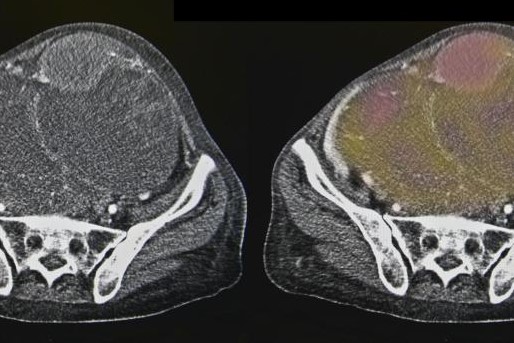
Ovarian cancer: symptoms, causes and treatment
What is ovarian cancer? Ovarian tumours are caused by the uncontrolled multiplication of its cells. They are divided into benign and malignant tumours
Among benign tumours, the most frequent are ovarian cysts, which are very often functional and disappear without treatment.
Malignant tumours are of three types: epithelial tumours, germ cell tumours and stromal tumours.
Epithelial tumours originate from the epithelial cells that superficially line the ovaries.
They are the most frequent, accounting for more than 90% of malignant ovarian tumours.
Germ cell tumours originate from the germ cells of the ovaries; they account for about 5% of malignant tumours and occur almost exclusively in juveniles.
Stromal tumours originate from the stroma of the ovary, are often characterised by low malignancy and account for about 4% of ovarian malignancies.
Symptoms of ovarian cancer
Ovarian cancer gives no symptoms in the early stages so it is difficult to identify it early.
The initial symptoms are fairly non-specific and often underestimated by women.
They are:
- lack of appetite
- swollen abdomen
- aerophagia
- need to urinate frequently
- feeling full even on an empty stomach
When these real alarm bells appear, it is a good idea to ask your gynaecologist for a simple pelvic ultrasound scan, which may give an important first diagnostic indication.
Ovarian cancer: what causes it?
Ovarian cancer is closely linked to age: most cases are identified after entering the menopause, between the ages of 50 and 69.
Moreover, the longer the woman’s fertile period, the greater the chance of this cancer occurring.
It has been thought that each ovulation represents a small trauma to the surface of the ovary from which the tumour arises; for this reason, all events that reduce the number of ovulations are potential causes.
Pregnancies, use of hormonal contraceptives, and breastfeeding are considered protective factors capable of reducing the risk of ovarian cancer occurrence.
The genetic factor also plays an important role; according to an estimate by the National Cancer Institute, between 7% and 10% of all cases are the result of a genetic alteration passed down through the generations consisting of mutation of the BRCA1 and BRCA2 genes that can cause ovarian cancer and breast cancer to occur simultaneously or at different times.
The risk rate for ovarian cancer is 39-46 per cent if a BRCA1 gene mutation is present and 10-27 per cent if a BRCA2 gene mutation is present.
Being a carrier of a mutation in these genes means a higher probability, but not certainty, of falling ill.
In this case, however, it is important to follow a programme of regular and thorough check-ups as well as to inform family members of age who may themselves be carriers of the mutation.
Bilateral annexiectomy (the surgical removal of the ovaries) is now recommended in women with the BRCA1 and BRCA2 gene mutation who have already had pregnancies or who are past childbearing age.
How widespread is ovarian cancer?
Ovarian cancer ranks ninth among cancers in Italy, affecting about 4,490 women every year, according to 2012 estimates by the Tumour Registry, and accounts for 2.9% of all cancer diagnoses.
It is uncommon in Asian, African and South American countries while in Europe it accounts for 5% of all female cancers.
Ovarian cancer prevention
Several screening programmes have been proposed involving the annual performance of a transvaginal ultrasound scan associated or not with the examination of a tumour marker: CA125; however, the results have been disappointing as CA125 is currently unreliable as it is too unspecific.
More reliable appears to be another recently introduced tumour marker: HE4, which has greater sensitivity and specificity.
Nevertheless, studies have shown that an annual visit to the gynaecologist who performs bimanual palpation of the ovary and transvaginal ultrasound control can facilitate early diagnosis.
Diagnosis of ovarian cancer
Diagnosis is often late.
A gynaecological examination with transvaginal ultrasound is essential; these are combined with laboratory tests to detect tumour markers such as CA125, CA19/9, HE4, CEA, alpha-fetoprotein.
A pelvic CT scan with contrast medium and a PET scan identifying regions of high metabolic activity may be helpful.
Ovarian carcinoma can be diagnosed in different stages:
I, limited to the ovaries;
II, on one or both ovaries and extending to the pelvic organs;
III, on one or both ovaries, extending to the pelvic organs and/or with metastases to the lymph nodes in the same area;
IV, with metastases also distant from the ovary area, usually to the liver and lungs.
A good or poor prognosis depends on the stage of the tumour at the time of diagnosis, which must be as early as possible.
Treatment is based on surgery, chemotherapy and the use of monoclonal antibodies
Surgery: surgery is fundamental in the treatment of ovarian cancer. In addition to removing the tumour, it allows accurate staging of the neoplasm. In patients with advanced disease, surgery, in addition to assessing the extent of the disease, is aimed at removing all visible tumour (cytoreductive surgery).
Chemotherapy: chemotherapy remains, after surgery, the cornerstone treatment for ovarian carcinoma. Paclitaxel and carboplatin are used.
Monoclonal antibodies: the tumour is closely linked to the neoformation of blood vessels that nourish and allow the neoplasm to grow. Drugs such as bevacizumab, a monoclonal antibody that specifically binds and blocks the VEGF (vascular endothelial growth factor) protein, which plays a key role in angiogenesis, have recently been used.
Read Also:
Emergency Live Even More…Live: Download The New Free App Of Your Newspaper For IOS And Android
Radiotherapy: What It Is Used For And What The Effects Are
Raising The Bar For Pediatric Trauma Care: Analysis And Solutions In The US
Brain Tumours: Symptoms, Classification, Diagnosis And Treatment
Non-Hodgkin’s Lymphoma: Symptoms, Diagnosis And Treatment Of A Heterogeneous Group Of Tumours
CAR-T: An Innovative Therapy For Lymphomas
What Is Vulvovaginitis? Symptoms, Diagnosis And Treatment
Symptoms And Treatment For Hypothyroidism
Hyperthyroidism: Symptoms And Causes
Surgical Management Of The Failed Airway: A Guide To Precutaneous Cricothyrotomy
Thyroid Cancers: Types, Symptoms, Diagnosis


